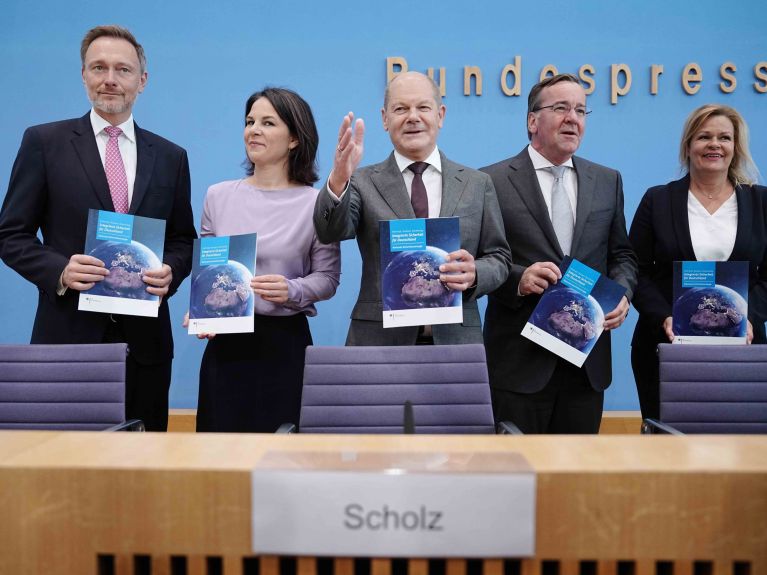Guiding principles for new security policy
Germany has its first-ever national security strategy. The key questions and answers about the Federal Government’s strategy.

The German government has delivered on one of its critical projects by creating Germany’s first-ever national security strategy. Federal Chancellor Olaf Scholz, Federal Foreign Minister Annalena Baerbock and other ministers presented the 40-page strategy, entitled “Integrated Security for Germany” in Berlin. The key questions and answers about the strategy.
Why has the Government developed a national security strategy?
The governing coalition of the SPD, Greens and FDP pledged in their 2021 coalition agreement to publish a strategy of this kind. In March 2022, less than a month after Russia’s invasion of Ukraine, Federal Foreign Minister Annalena Baerbock presented the general outline of the plans at an event marking the start of the development of the national security strategy. Baerbock said it was a matter of “security for the freedom of our lives”. She also called for a “comprehensive understanding of security”.
The strategy was published just under a year later and is intended to take into account all internal and external threats to Germany’s security. This ranges from military threats to potential cyber attacks and the effects of climate change. At the commencement event in March 2022, Federal Foreign Minister Baerbock described the climate crisis as “the security issue of our time”.
When presenting the finished strategy, Federal Chancellor Scholz described how the work had been guided by the principle of integrated security. In this, he said, issues which had previously been restricted to defence policy in Federal Government planning would now follow an overarching holistic approach.
How has the strategy been developed?
Practically the entire government was involved in work on the new strategy. The significance of the strategy was clear from the fact that it was presented jointly by Federal Chancellor Olaf Scholz, Federal Foreign Minister Annalena Baerbock, Finance Minister Christian Lindner, Defence Minister Boris Pistorius and Minister of the Interior Nancy Faeser. Others involved in developing the strategy included Germany’s international partners and experts on various aspects of security.
Members of the public were also included in the development of the security strategy, with public consultations held in seven cities during the spring and summer of 2022. “For me, a participative process for developing our strategy is also at the heart of what foreign policy means to me and our parliament,” Baerbock said. “After all, it isn’t just about sharing information between capital cities and government ministers, but also facilitating dialogue with people.”
What are the primary objectives for the strategy?
Describing the underlying principles behind the strategy, Federal Chancellor Scholz said, “Its objective is clear: ensuring the security of members of the public, and making our contribution towards the security of Europe.” Federal Foreign Minister Baerbock described how the goal of the first National Security Strategy was to “make us more resilient in all areas of our lives. Because new threats are complex and affect all areas of the state, society and our economy, we are extending our security policy across all these areas in an ‘integrated’ way.”
The Government sums up its plans under three key headings: on guard, resilient and sustainable. “The supreme task of German security policy is to ensure that we can continue to live in peace, freedom and security in our country in the heart of Europe,” the strategy states. It also acknowledges Germany’s unshakeable commitment to NATO and the EU, while also strengthening the Federal Armed Forces by pledging to invest 2% of the long-term average of GDP in defence.
The strategy covers a wide range of areas. These include protecting technical infrastructure, cyber and space security, raw materials security, energy security and food security, pandemic protection and fighting disinformation. The Federal Government also sees actions to protect the climate and maintain biodiversity as core tasks for security.
You can find the full National Security Strategy here.
Dieses YouTube-Video kann in einem neuen Tab abgespielt werden
YouTube öffnenThird party content
We use YouTube to embed content that may collect data about your activity. Please review the details and accept the service to see this content.
Open consent form


